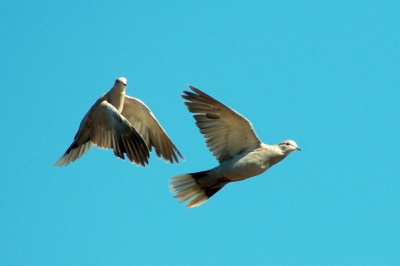
- Streptopelia decaocto
Identification
Length 32cm, weight 47cm.
A large, pale dove with a distinctive black collar around the back of the neck only - does not extend to the chin. The collar is often outlined with a thin white ring on both sides. Dark red eye, grey bill, dark primaries, and a long tail tipped in white.
Variation: subspecies xanthocycla has a bright yellow eye-ring.
Similar Species
Very similar to the African Collared Dove and other members of its genus; in much of the range the most likely member to be confused is Ringed Turtle Dove which probably is a domestic form of African Collared Dove; in the USA this is a rare and local feral bird, with established breeding colonies only in some southern cities, notably in California, but it is a frequent escape. Ringed Turtle Dove has white undertail coverts while this area is grey and often the darkest part of the belly in Eurasian Collared-Dove.
Outside of Streptopelia and in North America, the most important similar species is Mourning Dove, but Eurasian Collared-Dove is lighter in colour and tail is squared off rather than pointed.
Distribution
Europe, Asia, Caribbean and North America.
Native to south-eastern Europe and Asia, this dove expanded rapidly to the west and north during the 19xxs. It was introduced into the Americas in the Bahamas in 1974, soon made its way to Florida, and has been rapidly spreading across North America ever since. Published distribution maps can be considered obsolete very quickly; the species is now established well into the far western states, British Columbia, and the Great Lakes. There is some speculation that in North America it is occupying an ecological niche left vacant with the extinction of the Passenger Pigeon.
Taxonomy
Subspecies
This is a polytypic species consisting of two subspecies.[1]:
- S. d. decaocto:
- S. d. xanthocycla:
Habitat
Mostly suburban environments with light vegetation.
Behaviour
Movement
Forages on the ground, but frequently flies to perches in trees. Skilled and fast flyer.
Breeding
A twiggy platform nest in a bush, tree or building. The clutch consists of 2 glossy white eggs which are incubated for 16 to 17 days, fledging around 19 days later. There can be up to 3 broods per annum. Eggs may be laid at any time of the year.
Vocalisation
<flashmp3>Streptopelia decaocto (song).mp3</flashmp3>
Listen in an external program
References
- Clements, J. F., T. S. Schulenberg, M. J. Iliff, B.L. Sullivan, C. L. Wood, and D. Roberson. 2012. The eBird/Clements Checklist of Birds of the World. 6th ed., with updates to October 2012. Ithaca: Cornell Univ. Press. ISBN 978-0801445019. Spreadsheet available at http://www.birds.cornell.edu/clementschecklist/downloadable-clements-checklist
- Birdwatching Magazine
Recommended Citation
- BirdForum Opus contributors. (2024) Eurasian Collared Dove. In: BirdForum, the forum for wild birds and birding. Retrieved 3 May 2024 from https://www.birdforum.net/opus/Eurasian_Collared_Dove
External Links






